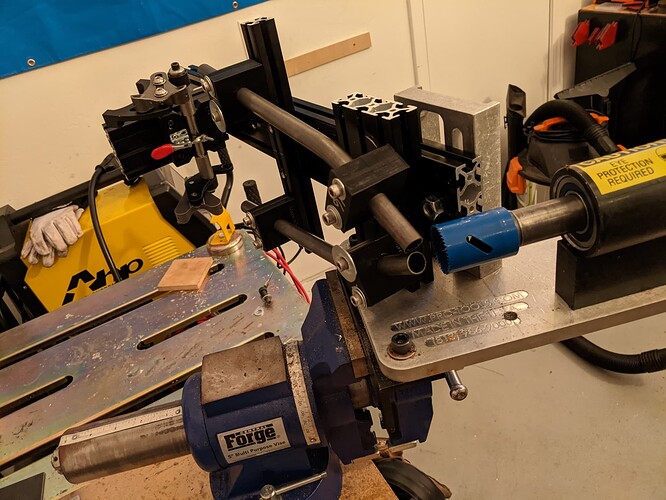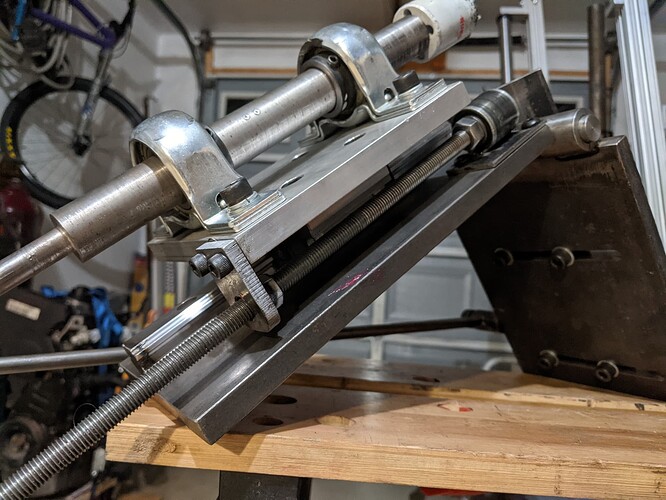In response to using the Anvil MTMF, I have been using one for many years now, mostly on a horizontal mill. That is a great way to have it mounted but it’s not moved off that mill. It can even fit on a small mill as long as the spindle to table distance is long enough. It’s great for holding tapered and bent tubes like chainstays and seatstays but not as rigidly or as nice as the Sputnik. The V-blocks are good enough but will take some learning on how to hold things and when to add tape to protect the tube from being dented. The recommendation @anon91558591 gave of cutting away the spindle side of the v-blocks is a great call to get the least stick out as possible especially on the really steep cuts.
There was a vertical mill model (what you have and an early version of it) and a horizontal version that had a different baseplate with a ruler to allow measured cuts. You don’t need that version to run it on a horizontal tho, but you don’t get the ruler so will be cutting to sharpie lines.
The main recommendation I have if you want to use this fixture is to use paragon tube blocks as the phasing mechanism instead of the tube dummies. I found it faster and easier to just put the tube block in the center of the tube and use a square against the MTMF to square it up. It’s more accurate than trying to use the dummy tubes in my experience.
But if it won’t fit on your mill anyways, why not just get more paragon tube blocks and use them at both ends of the tube and use those as the phasing mech in the mill vise? A digital angle finder can set the angle of the cut, super clean and simple. I’ve had to resort to this when mitering bent to tubes and some very extreme DT/ST cuts, and it made me ponder why I didn’t start doing it this way. The Cobra Daddy’s can help with tapered tubes while still using the tube block to phase. No need for the MTMF!
Tube notchers! When I look at these relatively inexpensive notchers I see the same issue as @anon91558591 with the tube clamping allowing for chatter. They also tend to run out of angle pretty quickly. The way the notcher is constructed with a long bushing, then a really long shaft with a hole saw on the end leaves additional room for chatter. The third issue to me (which was previously called out) out is the fact that there’s no way to control the feed rate. To me when working with thin enough tubing to make a bike out of, it’s pretty important to have good work holding, good hole saw holding, and some form of feed rate control. Fine tooth hole saws are a way to mitigate some of the issues of a tube notcher, but I still don’t think they really fix the rigidity issues which can result in notches being off center.
The work holding and hole saw rigidity issues of the inexpensive notchers available drove the design of the notcher that I made. Then when I needed to use it on bike tubing, it only took the saw grabbing one time to know that it needed a feed screw.
Its probably not an efficient method for a business, but its pretty easy to construct, I’d be happy to update the cad model and share it if it would be helpful, just let me know.
wow, I didn’t realize your jig had a screw feed! That’s a great idea. I’ll move this discussion to the new home made tools thread: Show off your shop-made/DIY Tools! - #2 by Daniel_Y
Awesome thanks so much for the info and context Whit! I have a few sizes of tube blocks and a Miter Daddy that I’ve been using so far, but very cool to get some more knowledge about this fixture. Great to hear some validation about not using the tube dummy, it seemed like a bit of a hassle to make dummies in the right size and perfectly squared up.
this is an amazing tool ![]()
My version of the MTMF came with several dummy tubes from 28.6 to 48mm. The only time I use them is when I want to use it as a stop, for doing multiple tubes of the same length. I’ve done very little production work but it helped for the handful of frames I did. Can also use it for square ends by not using the puck and rotating the holder sideways. Hard to explain but I’ve used it that way to miter several segmented fork legs of the same length.
If you don’t want it I’m sure it would sell quick!
I have the build pro notcher that uses the 5/8ths grid plate. Got it on sale from zoro so I could do practice welds without hand filing. The biggest issue is the y axis control to hit the tube centerline. It can best be described as clunky. The grid holes are pretty handy though, plenty of options for clamping. I’ve toyed with the idea of using some long bolts and a solid plate to make a “vise” to hold tube blocks.
Thanks! It works well!
Just to throw in an option for other home builders- a metal lathe works great for notching main tubes. I made a simple tubing clamp years ago, and bought a cheap dedicated tool holder. Combine this with one of paragon’s long holesaw arbors and you’re only in like $50 if you have a lathe. Drawback is larger and more complex stay clamps can be trickier to mount and achieve sufficient rigidity, but it can be done.
Very nice setup! I am curious, how big is the lathe you are using? Have you encountered any limitations (angle, torque, etc…)? What do you think the smallest lathe you can get away with?
Hi Daniel,
It’s a pretty basic geared-head single phase 13x40 Jet lathe. I have never had any power issues, and I run at a couple hundred RPM for notching.
As far as angle capability, if you remove the tailstock you can do nearly any angle, similar to a horizontal mill.
I like that it’s just another tool holder on my rack and I don’t have a dedicated fixture to mess with. Although initial setup is very quick, I think the main drawback is my tube clamping mechanism is slow, and requires patience to load properly. But it’s not a huge deal since I’m just building for fun.
I wouldn’t be surprised if a 9x20 lathe had the power (since people do this with hand-drills), I think a slightly more involved setup could achieve the rigidity needed, but really someone would have to try to find out. Any volunteers? ![]()
PS- I can’t believe the good fortune of the frame building community to have you start this. I plan to add to the intro thread, and I just finished your Fusion 360 tutorial. So awesome! Thank you!!
I’m thinking about getting a mini-lathe, like a 7x10 lathe, just to true up some hole saws for better mitering. I wonder what’s the smallest lathe I could get to do some actual mitering. If I removed the side cover and custom made a tooling post to rigidly hold a tube, maybe the mini lathe would work to notch some tubes?



